- You have no items in your shopping cart
- Continue Shopping
Sales 101 – The Ultimate Guide to Sales Strategy
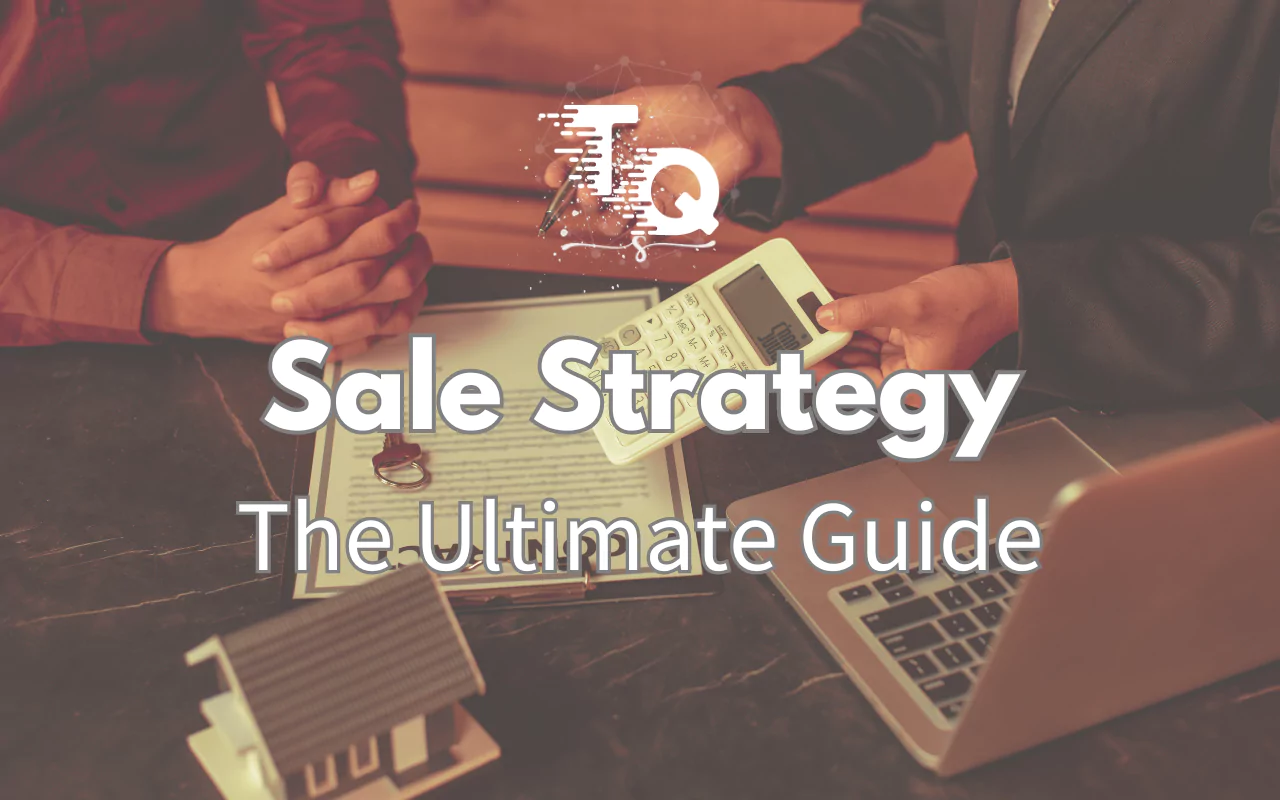
What is Sales Strategy?
A sales strategy is a comprehensive plan that positions a business’s products or services in the marketplace and facilitates efficient selling. It involves identifying unique selling propositions, setting sales goals, and outlining tactics to reach those goals. This strategy aligns your team’s efforts with your company’s overarching goals and provides a framework for what you’re selling, to whom, and how.Inbound vs. Outbound Sales Methodologies
Inbound Sales
Inbound sales focus on drawing customers in through content creation, SEO, social media, and other strategies that align with modern buyers’ behaviours, who often research online before purchasing.- Characteristics:
- Customer engagement-driven.
- Relies on content marketing, SEO, social media.
- Sales process begins when a customer contacts the company.
- Focuses on educating and nurturing prospects.
- Advantages:
- Aligns with customer-initiated buying processes.
- Builds long-term customer relationships.
- Often results in a lower cost per lead.
Outbound Sales
Outbound sales involve proactive outreach to potential customers through methods like cold calling, emailing, direct mail, or face-to-face meetings.- Characteristics:
- Salesperson initiates contact.
- Utilizes cold calling, emailing, advertising, and direct mail.
- Targets a broad audience.
- Advantages:
- Reaches customers who are unaware of the product/service.
- Direct control over the sales process.
- Effective for immediate sales efforts and targeted outreach.
Winning Sales Strategy Examples
- Solution Selling
- Value-based Selling
- Relationship Selling
- Consultative Selling
- Social Selling
1. Solution Selling
Solution Selling focuses on identifying and addressing the specific pain points or problems of the customer. The sales approach here is to position your product or service as the solution to these problems.
Example:
A software company selling project management tools might focus on how their software solves issues related to team collaboration and project tracking, specifically addressing the challenges a potential client faces in these areas.
2. Value-based Selling
This strategy emphasizes the value and benefits that a product or service brings to the customer. It's about demonstrating how the customer's investment will yield significant returns or benefits.
Example:
A car dealership might highlight the long-term cost savings, safety features, and environmental benefits of an electric vehicle over traditional gasoline cars, focusing on the overall value rather than just the price.
3. Relationship Selling
Relationship Selling is centred on building long-term relationships with customers. The focus is on customer satisfaction, loyalty, and building a rapport that encourages repeat business.
Example:
A real estate agent keeps in touch with past clients through regular updates, helpful tips on property maintenance, and market news, fostering a relationship that encourages clients to return or refer others.
4. Consultative Selling
This approach involves acting as a trusted advisor rather than just a salesperson. It's about understanding the customer's needs deeply and offering tailored solutions.
Example:
A financial advisor spends time understanding a client's financial goals, risk tolerance, and life stage, and then offers customized investment advice based on this detailed understanding.
5. Social Selling
Social Selling leverages social media platforms to connect with and engage potential customers. It involves building relationships and brand visibility online.
Example:
A fashion brand uses platforms like Instagram and Pinterest to showcase their products, engage with followers through comments and stories, and uses influencers to reach a broader audience.
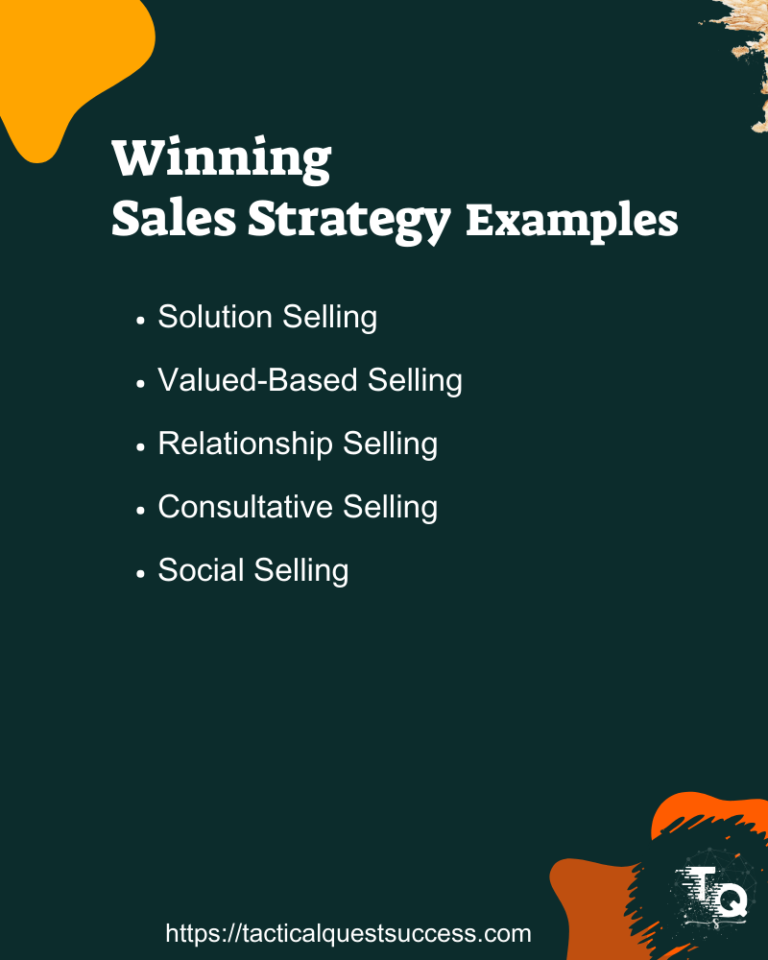
Sales Objections
What is Sales Objections
A sales objection is a concern or question raised by a potential customer that indicates hesitation or resistance to buying a product or service. It’s a natural part of the sales process, where prospects express doubts or seek clarification before making a purchasing decision.Handling sales objections effectively is a critical skill in the sales process. Objections are not necessarily a sign of disinterest but often indicate that the prospect needs more information or reassurance. Addressing these objections properly can turn a hesitant prospect into a confident customer.Understanding Common Objections
Identify and list common objections specific to your industry or product/service. These could include:- Price Concerns: “Your product/service is too expensive.”
- Effectiveness Doubts: “I’m not convinced your product/service will work for me.”
- Competition: “Another company offers a similar product/service at a lower price.”
- Timing: “Now is not a good time for us to purchase.”
- Trust Issues: “I’m not familiar with your company.”
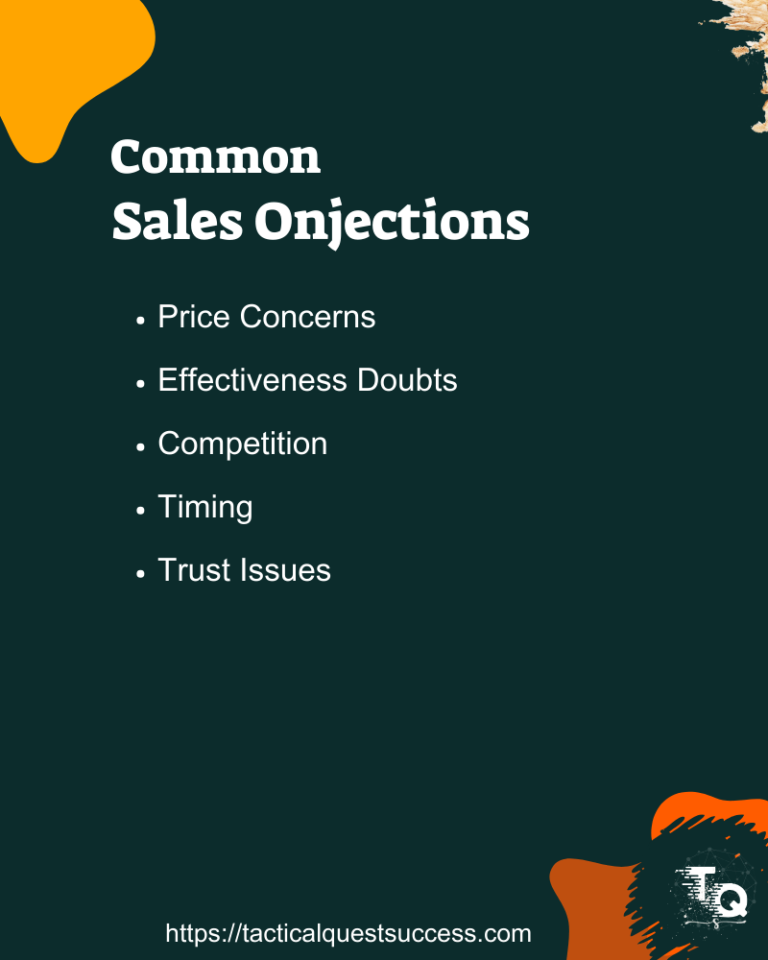
Importance in Sales
Understanding and addressing sales objections is crucial because:- It Indicates Interest: An objection often means the prospect is seriously considering the purchase but needs more information or reassurance.
- Opportunity for Engagement: Handling objections provides an opportunity to engage with the prospect, understand their needs better, and build a relationship.
- Improves Sales Strategy: Successfully addressing objections can improve the overall sales strategy, making it more effective in overcoming similar concerns in the future.
Developing Responses
Craft clear, concise, and persuasive responses for each objection:- Price Concerns: Explain the value and long-term benefits, offering comparisons that justify the cost.
- Effectiveness Doubts: Provide case studies, testimonials, or data that demonstrate the effectiveness of your product/service.
- Competition: Highlight what sets your product/service apart, focusing on unique features or superior quality.
- Timing: Discuss flexible options like trial periods or phased implementation.
- Trust Issues: Share your company’s history, achievements, and customer reviews to build credibility.
Examples of Developing Responses for each sales objection:
- Price Objection Response: “While our product may have a higher upfront cost, our customers find that the long-term savings and superior performance offer greater value over time.”
- Effectiveness Objection Response: “Let me share a case study where a business similar to yours saw a 50% increase in efficiency using our product.”
- Competition Objection Response: “While there are cheaper options available, our product offers a unique feature that saves you time and resources in the long run.”
- Timing Objection Response: “We understand that timing is crucial. Would a trial period help you assess the value of our product at no immediate cost?”
- Trust Objection Response: “Our company has been in business for over 10 years, and we’ve successfully served over 1,000 clients. Here are some testimonials from businesses similar to yours.”
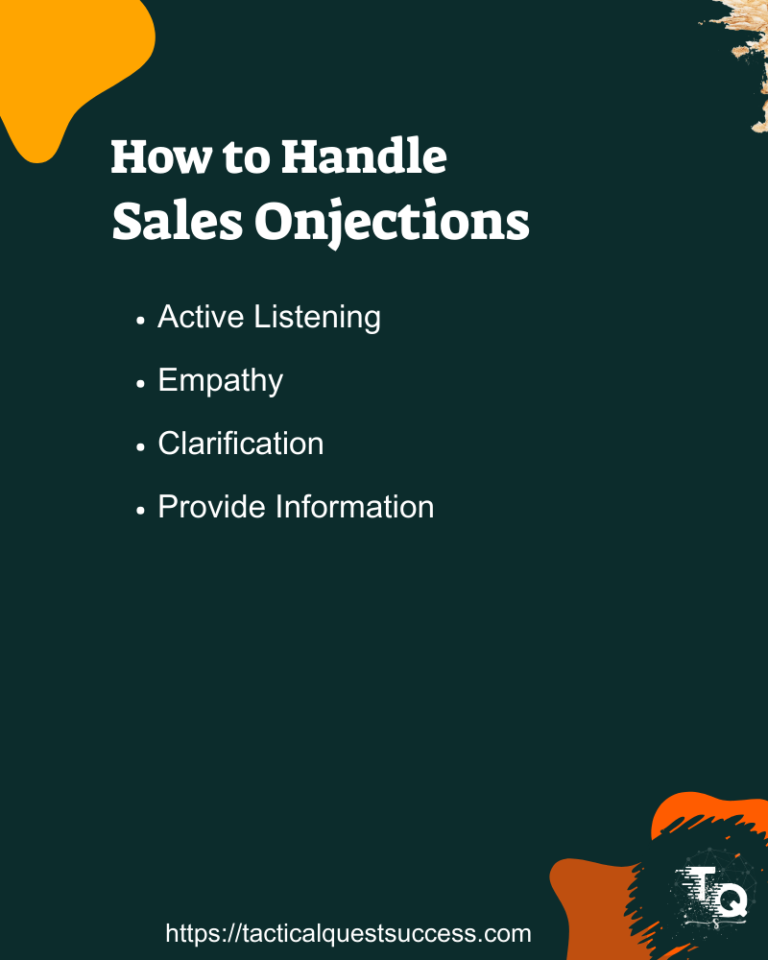
Handling Sales Objections
Effective handling of sales objections involves:
- Active Listening: Fully understanding the prospect’s concerns without making assumptions.
- Empathy: Demonstrating understanding and concern for the prospect’s situation.
- Clarification: Asking questions to clarify the objection and understand the underlying issues.
- Providing Information: Offering clear, factual information that addresses the specific concerns raised.
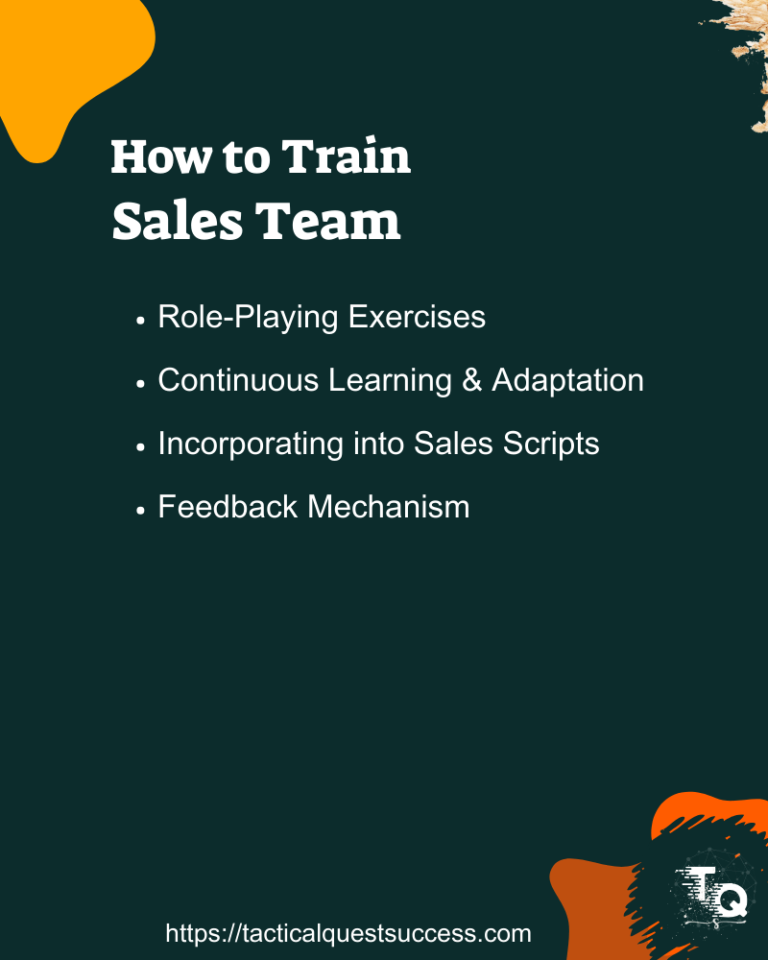
Training Sales Team
Ensure your sales team is well-versed in these responses. They should also be skilled in handling unexpected objections, using techniques mentioned above in Handling Sales Objections.
Role-Playing Exercises: Incorporate role-playing into training sessions, where team members practice responding to various objections. This helps build confidence and refine their approach.
Continuous Learning and Adaptation: Encourage the team to share their experiences and learn from each other. Regularly update your objection-handling strategies based on these insights.
Incorporating into Sales Scripts: Integrate objection handling into your sales scripts, ensuring a consistent and effective approach across the team.
Feedback Mechanism: Implement a system to gather feedback from prospects and customers on how objections were handled. Use this feedback to continuously improve your strategies.
Customise Sales Strategy for Your Business
- Identifying Your Target Market
- Crafting a Compelling Value Proposition
- Setting Clear Sales Goals
- Developing Effective Sales Processes
- Choosing the Right Sales Channels
- Implementing a Pricing Strategy
- Investing in Training & Development
- Utilising Sales Tools & Technology
- Monitoring Sales Performance
- Fostering Customer Relationships
- Conducting Competitive Analysis
- Embracing Adaptability
Customize Sales Strategy for Your Business
1. Identifying Your Target Market
Understanding your target market is crucial for tailoring your sales and marketing efforts effectively. This process involves:
- Demographic Segmentation: This includes age, gender, income level, education, and occupation. For instance, a luxury brand may target high-income individuals, while educational software might focus on students and educators.
- Geographic Segmentation: This refers to segmenting markets by location, such as country, region, city, or even neighbourhood. A local service business, like a restaurant, would focus on the immediate geographic area, while an e-commerce store might target specific regions where their products are popular.
- Psychographic Segmentation: This involves understanding the psychological attributes of your target market, including values, beliefs, interests, and lifestyle. For example, a fitness brand might target individuals who value health and wellness.
2. Crafting a Compelling Value Proposition
Your value proposition is a clear statement that explains how your product or service solves customers’ problems or improves their situation, delivering specific benefits. Here’s how to craft it:
- Identify Customer Pain Points: Understand the problems or needs your target market faces. For example, a cybersecurity company might focus on the customer’s need for protecting sensitive data.
- Highlight Unique Benefits: Explain what makes your product or service unique. This could be innovation, cost-effectiveness, quality, or customer service.
- Connect Benefits to Customer Needs: Show how the benefits of your product or service meet the identified customer needs. For instance, an eco-friendly clothing brand can highlight how it offers fashion while also being environmentally conscious.
3. Setting Clear Sales Goals
Setting clear, measurable, and achievable sales goals is vital for guiding your sales efforts and measuring success. Here’s how to approach this:
- Align with Business Objectives: Your sales goals should support the broader objectives of your business. For example, if the business aims to enter a new market, sales goals might focus on customer acquisition in that market.
- Make Goals Measurable: Ensure that your sales goals are quantifiable. For instance, instead of just aiming to ‘increase sales’, set a specific target like ‘achieve a 20% increase in sales over the next quarter’.
- Set Realistic Time Frames: Goals should be time-bound with clear deadlines. Short-term goals could be monthly or quarterly, while long-term goals might span over a year or more.
- Regular Review and Adjustment: Sales goals should be regularly reviewed and adjusted as needed based on performance and changing market conditions.
4. Developing Effective Sales Processes
Developing an effective sales process is about creating a repeatable set of steps that your sales team can follow to convert prospects into customers. Here’s how to approach it:
- Prospecting: This is the first step where sales representatives identify potential customers (leads). Methods include networking, online research, and using lead generation tools. The goal is to create a list of potential customers who might benefit from your product or service.
- Qualifying Leads: Not all prospects are a good fit. Qualifying leads involves assessing whether a prospect has the need, budget, authority, and timeline to buy your product. This step ensures that sales efforts are focused on leads with the highest conversion potential.
- Presenting Offers: This involves communicating the value of your product or service to the prospect. It should be tailored to address the specific needs and pain points of the lead, demonstrating how your offering is the solution they need.
- Handling Objections: Objections are natural. Sales reps need to be prepared to address common concerns or hesitations that prospects might have. This requires good product knowledge and understanding of customer pain points.
- Closing Deals: This is the final step where a prospect becomes a customer. Techniques for closing include summarizing the benefits, offering special terms, or creating a sense of urgency.
- Post-Sale Follow-Up: After closing a sale, follow up with the customer to ensure satisfaction and to lay the groundwork for future sales.
5. Choosing the Right Sales Channels
Selecting the right sales channels is critical to effectively reach and serve your target market. Here’s how to determine the most effective channels:
- Direct Sales: Involves selling directly to the customer, without any intermediaries. This can be through in-person meetings, phone calls, or direct emails. It’s particularly effective for high-value, complex products or services.
- Online Sales: Utilizing e-commerce platforms or your own website to sell products. This channel is essential in today’s digital world, especially for reaching a broader, potentially global audience.
- Channel Sales: Involves partnering with third parties, such as distributors, resellers, or affiliates, to sell your products. This is useful for expanding market reach without the need for a large in-house sales team.
- Retail Sales: For physical products, selling through retail stores (either your own or through partners) can be an effective channel.
- Hybrid Approach: Often, a combination of these channels works best, depending on your product, market, and customer preferences. For example, a software company might use direct sales for enterprise clients and online sales for smaller businesses.
Tips: In choosing sales channels, consider factors like your target market’s buying habits, the nature of your product or service, and your business’s resources and capabilities.
6. Implementing a Pricing Strategy
A well-thought-out pricing strategy is crucial for balancing competitiveness and profitability. Here’s how to approach it:
- Understand Your Costs: Know the cost of producing your product or service. This includes direct costs like materials and labour, as well as indirect costs like overhead.
- Analyse Market Conditions: Research your competitors’ pricing and understand where your offering fits in the market. Are you a premium product, or are you competing on price?
- Perceived Value: Price based on the value perceived by your customers. If your product offers unique benefits or superior quality, you can price higher.
- Customer Willingness to Pay: Understand your target customers’ price sensitivity. This can be gauged through market research.
- Dynamic Pricing: Consider using dynamic pricing strategies where prices change based on demand, time, or other factors.
7. Investing in Training & Development
Investing in your sales team’s training and development is essential for maintaining a competitive edge. Here’s how to do it effectively:
- Product Knowledge: Ensure your sales team understands your products or services inside out. This includes features, benefits, and how they meet customer needs.
- Sales Techniques: Train your team in various sales techniques, from prospecting and lead qualification to closing and follow-up.
- Customer Service Skills: Excellent customer service can differentiate your business. Train your team in communication, empathy, and problem-solving.
- Regular Refreshers: Keep your team updated with regular training sessions, especially when new products or features are launched.
8. Utilizing Sales Tools & Technology
Leveraging the right tools and technology can significantly enhance your sales team’s efficiency and effectiveness. Consider the following:
- CRM Systems: Customer Relationship Management (CRM) systems help manage customer data, interactions, and sales processes.
- Sales Automation Tools: Automate repetitive tasks like email follow-ups, lead scoring, and appointment scheduling.
- Data Analytics: Use analytics tools to gain insights into sales trends, customer behaviour, and performance metrics.
- Mobile Sales Tools: Equip your team with mobile tools for on-the-go access to customer data and sales materials.
9. Monitoring Sales Performance
Regularly tracking and analysing sales performance is vital for identifying areas for improvement and making informed strategic decisions. Here’s how to do it:
- Set KPIs: Establish Key Performance Indicators (KPIs) like sales revenue, conversion rates, average deal size, and customer acquisition cost.
- Regular Reviews: Conduct regular performance reviews to assess progress against goals.
- Data-Driven Insights: Use data analytics to uncover trends, patterns, and areas needing attention.
- Adjust Strategies: Be prepared to adjust your sales strategies based on performance data and changing market conditions.
10. Fostering Customer Relationships
Building and maintaining strong customer relationships is key to long-term business success. Here’s how to foster these relationships:
- Provide Excellent Service: Consistently deliver high-quality products and services. Ensure that every interaction adds value to the customer experience.
- Regular Communication: Keep in touch with customers through newsletters, updates, and personalized messages. This helps keep your brand top-of-mind.
- Feedback Mechanisms: Implement ways for customers to provide feedback, such as surveys or review systems. Use this feedback to improve your offerings.
- Loyalty Programs: Consider creating loyalty programs that reward repeat customers, encouraging continued business.
- Personalization: Tailor your communication and offers to individual customer preferences and purchase history.
11. Conducting Competitive Analysis
Understanding your competition is crucial for staying competitive. Here’s how to conduct an effective competitive analysis:
- Identify Competitors: Regularly identify and monitor key competitors in your market.
- Analyse Strategies: Look at their sales strategies, marketing campaigns, product offerings, and customer service approaches.
- Strengths and Weaknesses: Assess their strengths and weaknesses relative to your own business.
- Market Positioning: Understand how competitors position themselves in the market and how you can differentiate.
- Adapt and Innovate: Use insights from your analysis to adapt your strategy and innovate where you have competitive advantages.
12. Embracing Adaptability
In today’s fast-paced market, adaptability is crucial. Here’s how to ensure your sales strategy remains flexible:
- Stay Informed: Keep up with market trends, customer preferences, and technological advancements.
- Feedback Loops: Create mechanisms to regularly gather and analyse feedback from customers, sales teams, and market data.
- Agile Planning: Develop a sales strategy that can be adjusted quickly in response to new information or changing market conditions.
- Innovate: Be open to experimenting with new sales methodologies, technologies, and approaches.
- Training: Regularly train your team to handle new tools, technologies, and sales techniques.
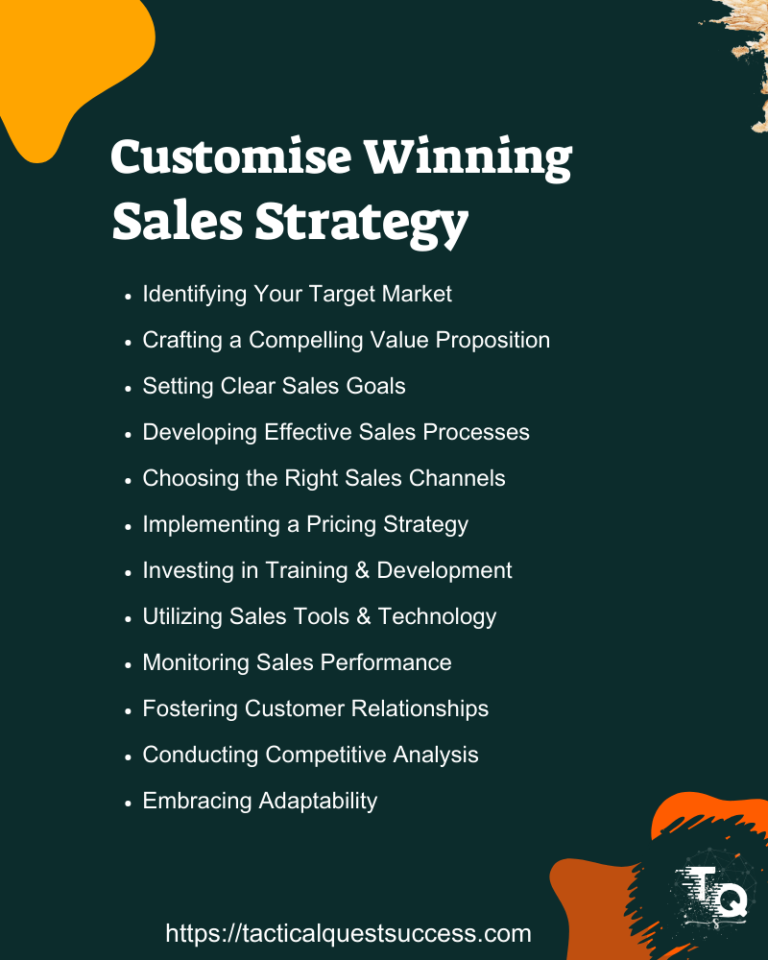
Measuring Sales Strategy Success
Measuring the success of your sales strategy is essential for understanding its effectiveness and making necessary adjustments. Here’s how to do it:- Sales Revenue: Track overall sales revenue to gauge the financial success of your sales efforts.
- Sales Growth: Measure the growth in sales over specific periods to understand the trajectory of your business.
- Conversion Rate: Analyse how effectively leads are being converted into customers.
- Customer Acquisition Cost (CAC): Calculate the cost of acquiring a new customer, including marketing and sales expenses.
- Customer Lifetime Value (CLV): Estimate the total value a customer is expected to bring over their relationship with your business.
- Regular Analysis: Regularly review these KPIs to assess the performance of your sales strategy and identify areas for improvement.
Understanding the Need for Measuring Sales Strategy Success
- Objective Performance Assessment
Measuring Key Performance Indicators (KPIs) offers an unbiased view of your sales strategy’s effectiveness. This approach is crucial for business owners, as it relies on data over intuition. - Identifying Strengths and Weaknesses
Analysing KPIs helps in pinpointing what’s working and what’s not in your sales strategy. This insight is vital for effective resource allocation. - Agility in Business
The business landscape is constantly evolving. Regular tracking of sales performance allows businesses to quickly adapt to market shifts and maintain competitiveness. - Goal Setting and Refinement
Measuring success aids in setting realistic goals and adjusting them as the business grows. Data-driven goals are more likely to be achievable and relevant. - Sales Process Optimization
Continual measurement leads to refining sales processes, essential for efficient sales cycles and higher conversion rates. - Understanding Customer Value
Metrics like Customer Lifetime Value (CLV) show the long-term value of customers. This information is crucial for businesses to target the most profitable customer segments. - Driving Revenue Growth
Measuring sales success is fundamentally about understanding and enhancing revenue growth. Strategies informed by KPIs can accelerate business growth and expand market presence.
Continuous Learning and Innovation in Sales
Stay ahead in the competitive sales environment by:
- Keeping Up with Sales Trends: The business world is always evolving; staying informed about the latest sales trends is key to success.
- Being Adaptable: Flexibility in sales strategies is essential. Be ready to modify your approach as the market and customer needs change.
Resources for Advancing Your Sales Knowledge
To enhance your sales expertise, consider these valuable resources:
- Educational Websites: Sites like Sales Hacker provide in-depth articles and insights specifically focused on sales strategies and innovations.
- Online Courses: Engage in structured learning about sales methodologies and techniques.
- Books and eBooks: Tactical Quest Success offers a comprehensive range of e-books tailored to various aspects of sales skills and strategies.
- Workshops and Seminars: Participate in these for practical, real-world experience in sales.
At Tactical Quest Success, you will find all the essential resources for mastering sales strategies, from detailed blogs to insightful eBooks, all designed to help you excel in the art of selling.
Conclusion
At Tactical Quest Success, we understand that a robust sales strategy is the backbone of success in the competitive business landscape. It's about more than just selling; it's about selling effectively to the right people, at the right time, and in the most efficient manner. We believe that successful sales strategies must be dynamic and adaptable, evolving continuously with market trends and customer needs.
As you navigate through your entrepreneurial journey, whether as a fresh graduate, a startup owner, or a seasoned business professional, our resources at Tactical Quest Success are designed to support you. We emphasize the importance of continual assessment and improvement to ensure your sales efforts remain effective, adapting as your business grows and the market changes. Let's embark on this journey together, leveraging adaptable and forward-thinking sales strategies to drive growth and success in today's ever-changing marketplace.
Click here to browse through our vast collection of eBooks.
Summary
| Section | Key Points |
|---|---|
| Understanding Sales Strategies | – Definition and importance of a sales strategy. – Aligns team efforts with company goals. – Framework for product/service positioning. |
| Inbound vs. Outbound Sales | Inbound Sales: Customer engagement, content marketing, SEO, social media. Outbound Sales: Salesperson initiated, cold calling, emailing, advertising. |
| Winning Sales Strategy Examples | 1. Solution Selling 2. Value-based Selling 3. Relationship Selling 4. Consultative Selling 5. Social Selling |
| Sales Objections | – Definition and importance. – Common objections: Price, Effectiveness, Competition, Timing, Trust. – Strategies for handling objections. |
| Customize Sales Strategy for Your Business | – Identifying target market. – Crafting value proposition. – Setting sales goals. – Developing sales processes. – Choosing sales channels. – Implementing pricing strategy. – Training and development. – Utilizing sales tools and technology. – Monitoring sales performance. – Fostering customer relationships. – Conducting competitive analysis. – Embracing adaptability. |
| Measuring Sales Strategy Success | – Importance of measuring success. – KPIs: Sales Revenue, Sales Growth, Conversion Rate, CAC, CLV. – Objective performance assessment. – Identifying strengths and weaknesses. – Agility in business. – Goal setting and refinement. – Sales process optimization. – Understanding customer value. – Driving revenue growth. |
| Conclusion | – Importance of a dynamic and adaptable sales strategy. – Continual assessment and improvement. – Integration of AI in sales strategy. |
Frequently Asked Questions (FAQs) about Sales Strategy
Focus on Customer Needs
Understand and address the specific requirements of your customers.Set Clear Goals
Define measurable objectives to guide your sales efforts.Effective Training
Regularly train your team in sales techniques and product knowledge.Adaptability
Stay flexible to adapt to market changes and customer feedback.
Practice Active Listening
Pay close attention to customer needs and feedback.Understand Your Product
Gain in-depth knowledge of your product to confidently address queries.Learn from Feedback
Use customer and peer feedback to continually improve your skills.
Builds Trust
Develop strong relationships with customers, fostering loyalty.Improves Service
Enables personalized service based on customer history and preferences.Increases Retention
Satisfied customers are more likely to be repeat buyers.
Understand Customer Needs
Tailor your pitch to address the specific needs of the customer.Provide Clear Solutions
Offer solutions that clearly solve the customer's problem.Prompt Follow-Up
Keep in touch with potential customers to address any lingering doubts.
Wider Audience Reach
Digital marketing can extend your reach to a broader audience.Targeted Marketing
Use online tools for targeted advertising based on user behavior and preferences.Lead Generation
Digital channels are effective for generating and nurturing leads.
Insight for Improvement
Feedback can highlight areas for product or service improvement.Tailor Products/Services
Use feedback to adjust offerings to better meet customer needs.
Listen and Empathize
Understand the customer's concerns before responding.Address Concerns Directly
Provide clear, factual responses to objections.Provide Reassurance
Offer reassurance through testimonials, data, or demonstrations.
Inbound Sales
Focuses on attracting customers through content and marketing efforts.Outbound Sales
Involves direct outreach to potential customers through calls, emails, etc.
Hire Motivated Individuals
Look for enthusiasm and a drive to succeed in potential hires.Provide Ongoing Training
Continuously develop the skills and knowledge of your team.Set Clear Goals
Establish clear, achievable targets for the team to strive towards.
Track Conversion Rates
Measure the percentage of prospects that turn into customers.Customer Acquisition Cost
Calculate the cost involved in acquiring new customers.Customer Lifetime Value
Understand the total value a customer brings over their relationship with your company.
Understand Customer Needs
Start by learning how to identify and understand customer requirements.Practice Effective Communication
Develop skills in clear, persuasive communication tailored to customer interests.
Networking
Build connections that can lead to new sales opportunities.Referrals
Use satisfied customers to generate leads.Social Media
Leverage social platforms for identifying and reaching potential customers.
- Streamline Customer Journey
Enhance each stage of the funnel, from initial awareness to the final purchase decision.
Targeted Marketing
Focus on reaching the right audience with tailored marketing efforts.Personalized Customer Interactions
Engage with potential customers in a personalized manner to increase conversion chances.
CRM Systems
Implement customer relationship management systems for better lead and customer management.Automation Software
Use automation tools for repetitive tasks to increase efficiency.
Personalize Communication
Tailor your outreach messages to the recipient.Leverage Social Media
Use social media platforms for outreach and engagement.Consistent Follow-Up
Regularly follow up with leads to keep them engaged.
Analyse Past Sales Data
Use historical sales data to predict future trends.Consider Market Trends
Stay informed about market changes that could impact sales.
Clarity
Keep the presentation clear and straightforward.Focus on Benefits
Highlight the benefits of your product or service.Engage with the Audience
Interact with your audience to keep them engaged and interested.
Timely Follow-Ups
Reach out to leads and customers promptly after initial contact.Personalized Messages
Tailor follow-up messages to address individual customer needs and interests.Address Specific Needs
Focus on how your product or service can meet the unique needs of the customer.
SEO can significantly impact a sales strategy by
Driving Qualified Leads
Attracting visitors who are actively searching for solutions that your business offers, leading to higher quality leads.Enhancing Online Sales Channels
Improving the visibility and accessibility of your online sales platforms, making it easier for potential customers to make purchases.
The relationship between SEO and sales conversion rates involves
Targeted Traffic for Higher Conversions
SEO brings in traffic that is more likely to convert because it targets users based on their search intent related to your products or services.Optimized Content for Sales Funnel
Creating content that aligns with different stages of the sales funnel, guiding potential customers towards making a purchase decision.
Explore comprehensive SEO Services.
Integrating SEO into a sales strategy can boost revenue by
Long-Term Customer Acquisition
Establishing a consistent flow of organic traffic that converts into sales, reducing reliance on short-term advertising.Building Trust and Credibility
High search engine rankings can enhance your brand’s credibility, which in turn positively influences purchasing decisions.
Explore more on SEO.

